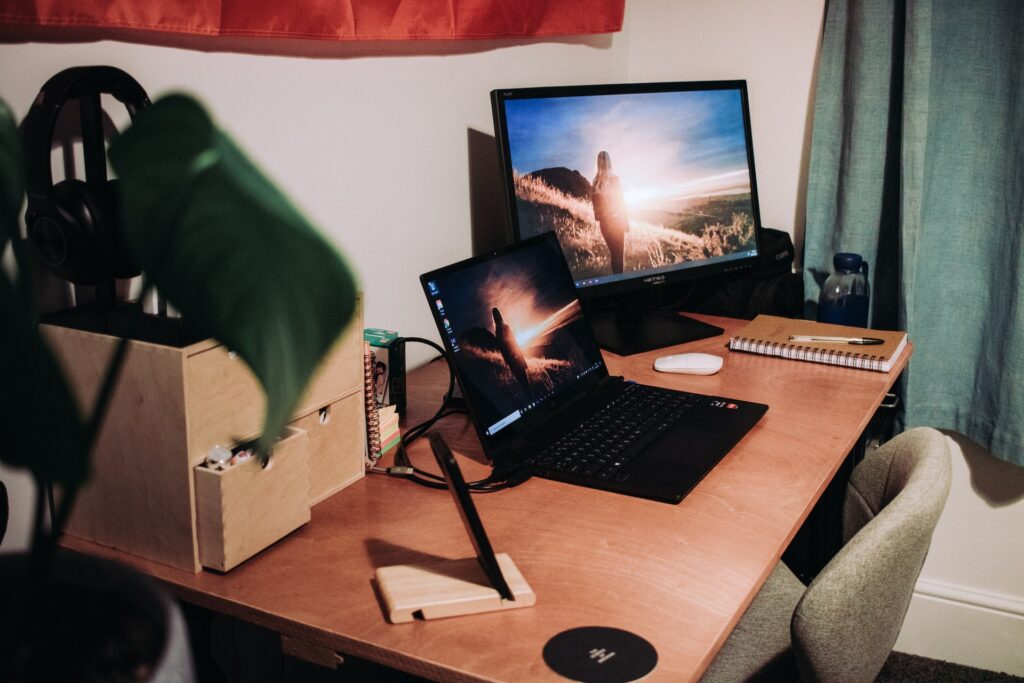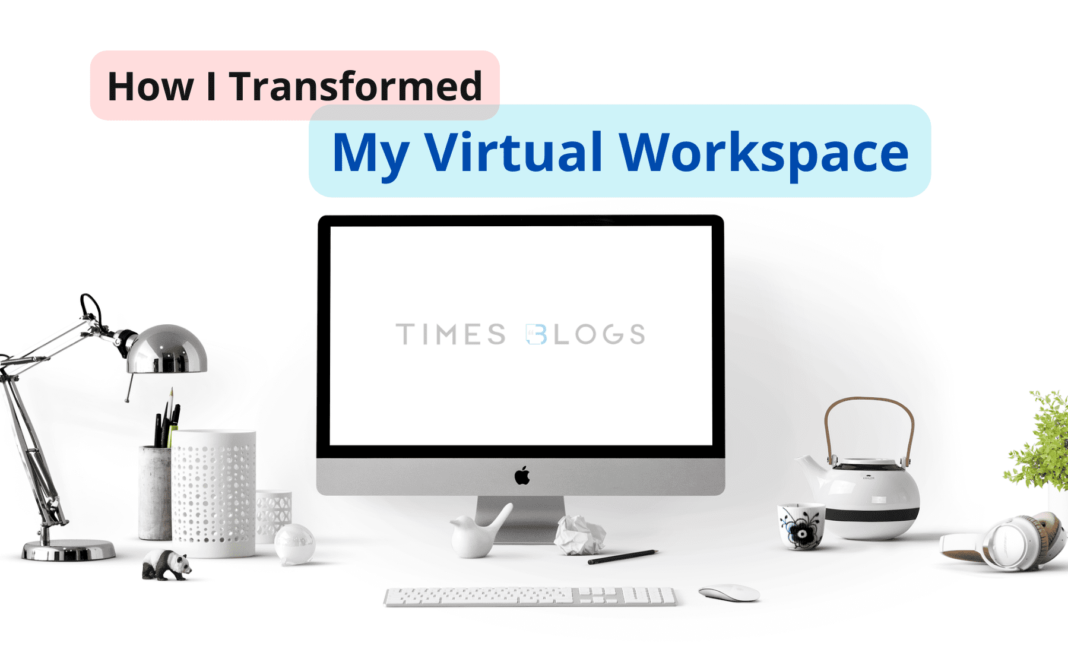Introduction
The New Norm: Virtual Workspaces
In the 21st century, the concept of work has undergone a monumental shift. Gone are the days when work was confined to physical offices, with employees commuting daily to a designated location. The new norm is a virtual workspace—a digital environment where work is no longer confined to a particular geographical location. With this newfound freedom, I began to explore ways to optimize my virtual workspace, and what follows is my journey toward enhanced productivity.
Why My Virtual Workspace Matters
The importance of a well-organized and efficient virtual workspace is often underestimated. A cluttered and unoptimized workspace can lead to distractions, delays, and a decrease in overall productivity. My virtual workspace had become just that—a disorganized mess that was costing me valuable time and energy. But I knew that with the right approach, I could transform it into a highly productive environment.
My Virtual Workspace: A Personalized Approach
One of the most appealing aspects of a virtual workspace is its flexibility. It can be tailored to fit individual needs and preferences. In my case, I had specific goals and requirements that needed to be addressed. My virtual workspace wasn’t just a place to complete tasks; it was a reflection of my work ethic and aspirations.
The Challenge of Transformation
Transforming my virtual workspace was no easy feat. It required a careful examination of existing tools, work habits, and overall goals. It wasn’t about merely choosing new software or rearranging files; it was about creating a whole new work environment that resonated with my vision and facilitated efficiency.
The Roadmap to Productivity
The process of revamping my virtual workspace was filled with challenges and discoveries. From understanding what wasn’t working to implementing new strategies, the transformation was a learning curve that I embraced wholeheartedly. This blog post details the steps I took, the tools I used, and the lessons I learned in my quest for a productive virtual workspace.
Table of Contents
Introduction to My Virtual Workspace
The concept of my virtual workspace started as a necessity and quickly evolved into a passion project. As someone who appreciates efficiency and organized workflow, I realized that my virtual workspace was an integral part of my professional life. Here’s an in-depth look into the different facets that defined my virtual workspace before the transformation and the importance of shaping it to suit my unique needs.

A New Reality: Embracing the Virtual
With the world transitioning to remote work at an unprecedented pace, the concept of a virtual workspace became not just an option but a new reality for many. For me, my virtual workspace wasn’t merely about a desk with a computer but an interconnected environment where technology and creativity met. It was my office, my conference room, and my creative space all rolled into one.
The Anatomy of My Virtual Workspace
My virtual workspace initially consisted of the essential tools that many of us are familiar with: a reliable computer, an internet connection, communication tools like email and instant messaging, and basic file management systems. However, I soon realized that these foundational elements were just the tip of the iceberg.
Software Tools
The virtual tools and software I used were the building blocks of my virtual workspace. From word processors to project management applications, these digital assets shaped the way I worked.
Hardware Considerations
The physical devices I used played a vital role in my virtual workspace. A computer with adequate processing power, a comfortable keyboard, and a well-calibrated monitor were essential components.
Collaborative Environment
Working remotely means collaboration takes on a new form. My virtual workspace included tools that allowed me to connect with my team, share ideas, and work collectively on projects.
The Need for Personalization
Every individual has unique working habits and preferences. I recognized that my virtual workspace should reflect my personality and cater to my specific needs. Whether it was choosing a specific color scheme for my digital notes or arranging files in a particular order, the personal touch made my virtual workspace feel like my own.
Challenges in My Virtual Workspace
The transformation of my virtual workspace was driven by the need to overcome certain challenges that were affecting my productivity and overall work satisfaction. While my virtual workspace provided countless conveniences, it was not without its obstacles. Below, I will share the challenges that I encountered in my virtual workspace, and how they became the catalyst for change.
1. Disorganization and Clutter
In my virtual workspace, files, emails, and digital notes began to pile up, leading to a cluttered and chaotic environment. Searching for a particular document or retrieving specific information became time-consuming, draining my energy, and negatively impacting my efficiency.
2. Inefficient Communication and Collaboration
Remote working requires seamless communication and collaboration tools. In my virtual workspace, I found that some tools were either outdated or not well-suited for my team’s needs. This led to miscommunications, delays in projects, and frustration among team members.
3. Lack of Personalization and Adaptability
As previously mentioned, a virtual workspace should reflect personal work styles and preferences. My virtual workspace initially lacked personal touches and adaptability, making it feel sterile and uninviting. This affected my motivation and connection to the space.
4. Technical Issues and Limitations
Nothing can disrupt a workday in a virtual workspace like technical issues. Slow internet connectivity, software crashes, and hardware limitations became recurring problems in my virtual workspace. These technical hitches were more than mere annoyances; they disrupted the flow of work and often led to lost time.
5. Distractions and Lack of Focus
Working virtually often means exposure to countless distractions. From social media notifications to the temptation of browsing unrelated content, my virtual workspace became a battleground for focus and concentration. Maintaining a disciplined approach became a challenge in itself.
6. Security Concerns
With the increase in cyber threats, maintaining the security of my virtual workspace became a significant concern. Ensuring that files, communications, and digital interactions were protected required additional measures and constant vigilance.
7. Work-Life Balance
Blurring the lines between personal life and work life is a common challenge in virtual workspaces. In my case, disconnecting from work and maintaining a healthy work-life balance became increasingly difficult as my virtual workspace began to permeate every aspect of my daily life.
Transforming My Virtual Workspace: A Step-by-Step Guide
After recognizing the challenges in my virtual workspace, it was time to embark on a transformation journey. The process required careful planning, thoughtful decision-making, and a commitment to change. Below is the step-by-step guide that I followed to overhaul my virtual workspace, turning it from a chaotic environment into a productive sanctuary.
Step 1: Identifying Specific Needs and Goals
The transformation began with a clear understanding of what I needed from my virtual workspace. By identifying specific pain points and setting clear goals, I was able to formulate a tailored plan that resonated with my work style and needs.
Step 2: Assessment and Evaluation
I undertook a comprehensive assessment of my virtual workspace, evaluating the existing tools, file organization, communication methods, and personalization. This helped me see what was working and what required immediate attention.

Step 3: Selecting the Right Tools
This step involved choosing the right tools to enhance my virtual workspace. From project management platforms to communication software, selecting tools that were user-friendly and aligned with my goals was crucial.
- Communication Tools: I opted for apps that enabled easy collaboration and real-time communication.
- Project Management Tools: Implementing platforms that allowed for organized task tracking and team collaboration was vital.
- Security Tools: Ensuring my virtual workspace was secure meant investing in reliable security software.
Step 4: Reorganizing and Decluttering
A significant part of transforming my virtual workspace involved reorganizing files, documents, and digital assets. This step was essential in creating a streamlined and clutter-free environment.
- File Organization: Creating folders, using descriptive naming conventions, and regularly updating files helped in maintaining order.
- Email Management: I implemented rules and filters to organize emails, reducing clutter and enhancing accessibility.
Step 5: Implementing Time Management Strategies
Effective time management was key to enhancing productivity in my virtual workspace. Techniques such as time-blocking and the Pomodoro Technique became part of my daily routine.
Step 6: Personalizing My Virtual Workspace
Adding personal touches that reflected my personality made my virtual workspace feel more comfortable and inspiring. Whether it was customizing the desktop wallpaper or choosing specific themes within apps, this step made a significant difference.
Step 7: Regular Monitoring and Adjustments
Transforming my virtual workspace was not a one-time activity. Regularly reviewing and making necessary adjustments ensured that the workspace continued to evolve and adapt to my changing needs.
Tools That Enhanced My Virtual Workspace
When transforming my virtual workspace, selecting the right tools was paramount. The technology and platforms that I utilized played a significant role in shaping the way I worked, communicated, and managed tasks. Below, I’ll explore the tools that were instrumental in enhancing my virtual workspace, each serving a specific function and contributing to a more efficient and enjoyable work environment.

1. Project Management Tools
- Trello: For visually organizing tasks and projects, Trello’s boards and cards offered a flexible and intuitive system that enhanced my workflow.
- Asana: This tool allowed me to create detailed project timelines, assign tasks, and track progress, fostering accountability and collaboration within my team.

2. Communication and Collaboration Tools
- Slack: With its channel-based communication, Slack made team collaboration seamless, reducing email clutter and keeping conversations organized.
- Zoom: For video conferencing and virtual meetings, Zoom provided a reliable platform that helped me stay connected with clients and team members.

3. File Storage and Organization Tools
- Google Drive: The cloud-based storage of Google Drive allowed me to access files from anywhere, ensuring that my virtual workspace extended beyond my home office.
- Dropbox: With its syncing capabilities, Dropbox ensured that all my files were up-to-date across devices, promoting a unified virtual workspace.

4. Productivity and Time Management Tools
- Todoist: This task management tool helped me prioritize daily tasks, set reminders, and stay on top of deadlines.
- Pomodone: Integrating the Pomodoro Technique, Pomodone assisted me in maintaining focus and taking regular breaks to keep my mind fresh.

5. Security Tools
- NordVPN: To safeguard my online activities, NordVPN provided encrypted internet access, ensuring the security of my virtual workspace.
- LastPass: Managing passwords securely and conveniently, LastPass offered peace of mind, knowing that my accounts and data were protected.
6. Personalization and Aesthetic Tools
- Rainmeter: For customizing my desktop, Rainmeter allowed me to create a visually appealing and personalized virtual workspace that boosted my motivation.
- Notion: As an all-in-one workspace tool, Notion let me create notes, manage tasks, and build databases in a way that resonated with my personal style.
7. Health and Well-being Tools
- Stretchly: Recognizing the importance of well-being, Stretchly reminded me to take regular breaks, ensuring that my virtual workspace was also a place for self-care.
Measuring Productivity in My Virtual Workspace
Productivity is often the yardstick by which the effectiveness of a workspace is measured, and my virtual workspace was no exception. The transformation I undertook was aimed at enhancing productivity, but quantifying that improvement required careful consideration and a thoughtful approach. In this section, I’ll outline how I measured productivity in my virtual workspace and the key metrics that allowed me to gauge success.
1. Setting Clear Objectives and Key Results (OKRs)
Defining what productivity meant to me was the first step in measuring it. By setting clear Objectives and Key Results (OKRs), I was able to align my virtual workspace transformation with specific, measurable goals.
- Objectives: These were broad goals like “Improve Project Completion Rate” or “Enhance Team Collaboration.”
- Key Results: These were quantifiable outcomes tied to the objectives, such as “Complete 90% of projects on time” or “Reduce email response time by 25%.”
2. Utilizing Time Tracking Tools
Time is a valuable resource, and understanding how it was spent in my virtual workspace was crucial.
- Time-Tracking Software: Tools like Toggl allowed me to log hours spent on different tasks, offering insights into where time was utilized most efficiently.
- Self-Reflection: Regularly reviewing time logs helped me identify areas for improvement and adjust my work patterns accordingly.
3. Monitoring Task Completion and Deadlines
Measuring productivity also involved tracking task completion rates and adherence to deadlines.
- Project Management Dashboards: Platforms like Asana provided visual representations of task progress, allowing me to gauge if projects were moving forward as planned.
- Weekly Reviews: Assessing completed tasks and missed deadlines on a weekly basis helped me identify bottlenecks and make necessary adjustments.
4. Evaluating Communication Efficiency
In a virtual workspace, effective communication is key to productivity. I measured this aspect by:
- Analyzing Response Times: Quicker response times in team communication channels indicated improved collaboration and information flow.
- Surveying Team Satisfaction: Regular feedback from team members on communication tools and practices provided qualitative insights into what was working and what needed refinement.
5. Assessing Personal Well-Being and Satisfaction
Productivity is not just about output; it’s also about personal well-being and job satisfaction.
- Self-Assessment Surveys: Periodically evaluating my mental well-being, work satisfaction, and overall happiness gave me a holistic view of productivity in my virtual workspace.
- Work-Life Balance Metrics: Tracking the number of hours worked daily and the ability to disconnect from work helped me ensure that productivity did not come at the cost of personal life.

Conclusion: Reflecting on the Transformation of My Virtual Workspace
The transformation of my virtual workspace has been more than just a series of changes in tools, organization, and work habits. It has been a journey of self-discovery, learning, and growth. As I conclude this comprehensive look into my virtual workspace’s transformation, I’d like to reflect on some key takeaways that resonate beyond the digital realm.
1. Personalization Matters
One of the most significant lessons was the importance of personalization. Tailoring my virtual workspace to reflect my personality, work style, and unique needs made it a place of inspiration and motivation. It became an extension of myself rather than just a functional space.
2. Flexibility and Adaptability
The virtual workspace’s ability to evolve and adapt to changing needs and circumstances proved vital. From trying out different tools to adjusting time management strategies, flexibility allowed my virtual workspace to stay relevant and efficient.
3. Communication is Key
Effective communication was the linchpin that held everything together. Whether it was team collaboration or client interactions, choosing the right communication tools and practices had a profound impact on productivity and satisfaction.
4. Security Cannot Be Overlooked
The increased reliance on digital tools brought forth the significance of security in my virtual workspace. Protecting data, managing passwords, and maintaining privacy became integral to creating a trustworthy and secure working environment.
5. Well-being and Work-Life Balance
Ensuring that productivity did not overshadow personal well-being and work-life balance was a delicate and essential aspect of the transformation. My virtual workspace needed to be a place of not just efficiency but also self-care and mindfulness.
6. Continuous Learning and Growth
The transformation was not a destination but a continuous process. Regular assessments, learning from successes and failures, and being open to new ideas and methods kept my virtual workspace vibrant and responsive.
Final Thoughts
The transformation of my virtual workspace was about embracing the future of work while staying grounded in human values and individual needs. It was about finding harmony between technology and creativity, efficiency and empathy, productivity and personal expression.
As we navigate an increasingly digital world, our virtual workspaces will continue to play a central role in how we work, create, and connect. Whether you are embarking on a transformation journey or simply looking to enhance your existing virtual workspace, I hope that the insights, strategies, and reflections shared in this blog have inspired you to view your virtual workspace as a canvas for innovation, growth, and personal fulfillment.
Remember, your virtual workspace is more than just a place to work; it’s a reflection of who you are and what you aspire to be. Make it yours, make it resonate, and let it be a catalyst for greatness in all that you do.
Thank you for joining me on this journey. Here’s to our virtual workspaces and the endless possibilities they hold!




